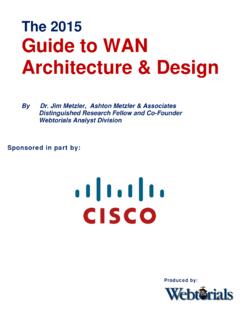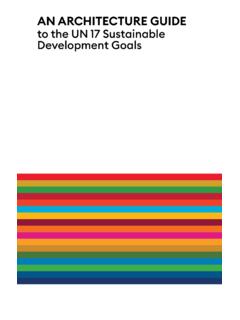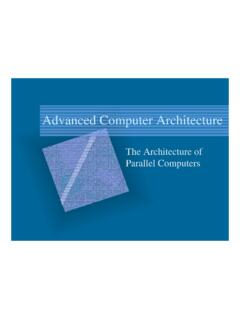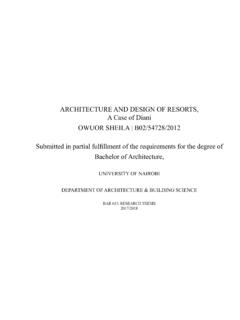Transcription of Solution Architecture Template (SAT) Design Guidelines
1 Solution Architecture Template (SAT) Design Guidelines Solution Architecture Template (SAT) Design Guidelines Change control Modification Details Version Alignment with EIRA Version Initial version ISA Action - European Interoperability Architecture Page 1 of 25. Solution Architecture Template (SAT) Design Guidelines ArchiMate and TOGAF are registered trademarks of The Open Group. ArchiMate and TOGAF are copyright of The Open Group. All rights reserved. Archi is a registered trademark of Phillip Beauvoir. ISA Action - European Interoperability Architecture Page 2 of 25. Solution Architecture Template (SAT) Design Guidelines Table of Contents 1 INTRODUCTION .. 4. PURPOSE OF THIS DOCUMENT .. 4. TARGET AUDIENCE .. 4. FURTHER 4. 2 INTRODUCTION TO Solution Architecture 5. THE EUROPEAN INTEROPERABILITY REFERENCE Architecture .. 5. WHAT IS A Solution Architecture Template .. 6. BENEFITS OF AN 7. HOW CAN AN SAT BE USED?
2 7. 3 WHAT ARE THE Guidelines OF DESIGNING A Solution Architecture Template ? .. 8. EIRA VIEWS - Design 8. Architecture BUILDING BLOCKS - Design Guidelines .. 8. Solution BUILDING BLOCKS - Design Guidelines .. 9. INTEROPERABILITY SPECIFICATIONS - Design 10. ARCHIMATE MOTIVATION EXTENSION .. 12. NARRATIVES .. 14. 4 TOOLING SUPPORT ..15. 5 SAT DEVELOPMENT LIFECYCLE ..16. INITIATION OF AN 16. Perform a preliminary assessment .. 16. GET APPROVAL TO DEVELOP THE SAT .. 16. DESIGNING THE SAT .. 16. Define motivation and use-cases .. 17. Identify and document your target audience .. 17. Identify the required EIRA's building blocks .. 17. Create a blueprint .. 18. Identify existing entities that should be reused .. 19. Add interoperability specifications .. 19. Add a narrative to each view .. 20. PUBLISHING THE SAT .. 20. SAT CHANGE MANAGEMENT .. 21. 6 CONCLUSION ..22. APPENDIX: Design Guidelines .
3 23. APPENDIX: GLOSSARY ..24. APPENDIX: ACKNOWLEDGEMENTS ..25. ISA Action - European Interoperability Architecture Page 3 of 25. Solution Architecture Template (SAT) Design Guidelines 1 INTRODUCTION. Purpose of this document This document explains the purpose of a Solution Architecture Template (SAT) and how to Design one. It starts by explaining what the use-cases of the EIRA are, how an SAT can be used in certain of those use-cases and what the benefits of an SAT are. The different steps on how to create and use an SAT are explained afterwards. This document gives a small introduction to the EIRA , the document does not try to explain the EIRA in depth, nor how the EIRA can be used, however. Detailed information on the EIRA . is available on the Joinup page1. Target audience This document targets enterprise/ Solution architects involved in the Design of SAT's based on the EIRA . Further information This document is part of the EIRA support series, more information on the EIRA itself can be found on the Joinup page2.
4 This page provides download links to the EIRA modelled using ArchiMate , the overview document that explains the EIRA and tooling support is available via the CarTool 3. Finally, the following four SATs (beta versions at the time of the writing of this document) are available as well: Open Data SAT ( beta). eHI SAT ( beta) Human Interfaces eID SAT ( beta). eDelivery SAT ( beta). 1. 2. 3. ISA Action - European Interoperability Architecture Page 4 of 25. Solution Architecture Template (SAT) Design Guidelines 2 INTRODUCTION TO Solution Architecture TEMPLATES. The European Interoperability Reference Architecture The Solution Architecture Templates that are described in this document are based on the European Interoperability Reference Architecture (EIRA ) , a four-view reference Architecture for delivering interoperable digital public services across borders and sectors. It defines the required capabilities for promoting interoperability as a set of Architecture building blocks (ABBs).
5 The EIRA has four main characteristics: Common terminology to achieve a minimum level of coordination: It provides a set of well-defined ABBs that provide a minimal common understanding of the most important building blocks needed to build interoperable public services. Reference Architecture for delivering digital public services: It offers a framework to categorise (re)usable Solution building blocks (SBBs) of an e-Government Solution . It allows portfolio managers to rationalise, manage and document their portfolio of solutions . Technology- and product-neutral and a service-oriented Architecture (SOA). style: The EIRA adopts a service-oriented Architecture style and promotes ArchiMate . as a modelling notation. In fact, the EIRA ABBs can be seen as an extension of the model concepts in ArchiMate . Alignment with EIF and TOGAF : The EIRA is aligned with the New European Interoperability Framework (EIF)4 and complies with the context given in the European Interoperability Framework Implementation Strategy (EIF-IS)5.
6 The views of the EIRA . correspond to the interoperability levels in the EIF: legal, organisational, semantic and technical interoperability. Within The Open Group Architecture Framework (TOGAF )6 and the Enterprise Architecture Continuum, EIRA focuses on the Architecture continuum. It re-uses terminology and paradigms from TOGAF such as Architecture patterns, building blocks and views. The EIRA uses views to model the different aspects of interoperability. Although interoperability almost always involves exchanging data between ICT systems, interoperability is a wider concept and encompasses the ability of organisations to work together towards mutually beneficial and commonly agreed goals. The different views that are used to express this interoperability are Legal view , Organisational view , Semantic view and Technical view . An additional view called EIF Underlying Principles view contains goals and principles that describe the context in which European public services are designed and implemented.
7 4. 5. 6. ISA Action - European Interoperability Architecture Page 5 of 25. Solution Architecture Template (SAT) Design Guidelines The EIRA uses the following key elements in the development of specific solutions : EIRA view: The EIRA consists of several views, including one view for each of the EIF. interoperability levels. EIRA viewpoints: The EIRA defines several viewpoints containing a selection of building blocks from the different views, to address the needs of specific stakeholders. SATs should include at least the High-level viewpoint, which provides an introductory view by highlighting the focal ABBs of the SAT. Architecture Building Block: Based on the TOGAF definition, an Architecture building block is an abstract component that captures Architecture requirements and that directs and guides the development of Solution building blocks. An ABB represents a (potentially re-usable) component of legal, organisational, semantic or technical capability that can be combined with other Architecture building blocks.
8 An Architecture building block describes generic characteristics and functionalities. Architecture building blocks are used to describe reference architectures, Solution Architecture templates or Solution architectures of a specific solutions . Solution Building Block: Based on the TOGAF definition, a Solution building block is a concrete element that implements the required capabilities of one or more Architecture building blocks. On the technical view, a Solution building block is a specific product or software component. More information on the EIRA can be found on Joinup7 where documentation is available, the model can be downloaded and other supporting material like the CarTool and other SATs are available for consultation. What is a Solution Architecture Template A Solution Architecture Template (SAT) is a specification extending the EIRA providing support to Solution architects in a specific Solution domain in the form of a Template that can be used to Design related solutions .
9 An SAT contains the following elements: A motivation in the form of principles and requirements. A goal and a description of the supported functionalities. A sub-set of the EIRA core Architecture Building Blocks (ABBs) covering the four EIF. layers. A set of specific ABBs extending EIRA 's views enabling specific functionalities to be provided by implementations derived from the SAT. The interoperability specifications of selected ABBs and a narrative for each EIRA view. 7. ISA Action - European Interoperability Architecture Page 6 of 25. Solution Architecture Template (SAT) Design Guidelines Benefits of an SAT. The benefits of a SAT are the following: Provides architects with a common approach to cope with a specific interoperability challenge. It also places the focus on the key-points you need to consider when building a Solution in a specific problem area. An architect can create a Solution Architecture by mapping existing Solution Building Blocks (SBBs) to an SAT, based on the interoperability specifications that are provided.
10 This is done by realising the ABBs identified in the SAT by specific SBBs. When an architect creates an SAT, he/she can define the interoperability specifications for the SAT's ABBs and moreover recommend specific SBBs so that the selection of specific solutions is facilitated and is ensured to have more interoperable results. An SAT can be created within and across the different views of the EIRA . An SAT can then support architects specialised in different interoperability levels. How can an SAT be used? An SAT can be used in the following ways: As a tool to help you Design your Solution . An SAT serves as blueprint for architects to build solutions and guides them in indicating the elements, which should be implemented as well as the elements that are already available and should be taken into account. These elements can have a legal bases, can apply to organisational processes or can have a technical nature.




